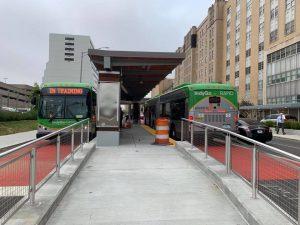
My latest piece is online at CityLab. It’s a look at the transit improvement plans in Indianapolis as the city’s first Bus Rapid Transit line on September 1st. Indy’s system is a model for how lower density cities with auto-centric cultures can start making major improvements in their transit offerings in a capital efficient way. (Transport guru Yonah Freemark likewise holds the Indy system in high regard, writing in Streetsblog back in 2017 that it is going to be “like launching a brand new transit system.”).
Indy is upgrading its system in several ways:
- Three BRT spines totaling 62 miles and 97 stations. (Features: level boarding, exclusive lanes for a majority of the route, transit signal priority, offboard fare collection, all electric buses, 10 minute all day service, etc).
- A new, grid based bus network with several high frequency routes – a game changer vs. the current hub and spoke system with buses mostly coming every 30 or 60 minutes.
- Significantly greater spans of service, with all routes running every day.
- A new fare collection system with mobile device integration, fare capping, etc.
The whole thing is set to be delivered by 2025 (about five years). And the price tag is reasonable. The BRT system at full buildout in Marion County is only $500 million. The first line was 80% federally funded, and if future lines achieve the targeted 50% federal funding, the total local cost will only be $220 million. And that will include massive street improvements the city desperately needs – drainage, pavement, sidewalks, signals, and many miles of new sidewalks where none currently exist.
This is a much, much better approach to getting in the transit game than trying to just straight to a multi-billion dollar light rail system.
Here’s an excerpt from my piece.
The BRT buses themselves—all-electric articulated coaches from BYD—are a major upgrade over the standard models. Riders will get amenities like Wi-Fi, USB ports, and automated announcements; a series of attractive new bus stations will feature arrival time information and an integrated snow melt system. But while the Red Line will be America’s first all-electric BRT line and only the third system with fare capping, the features alone are not groundbreaking. What stands to be transformative is the overall impact the improvements could have on Indianapolis, which is currently saddled with a little-used bus system featuring lines running every 30 or 60 minutes.
The BRT line is just one part of an improved overall bus network redesigned by Jarrett Walker & Associates, the firm led by transit consultant (and occasional CityLab contributor) Jarrett Walker. This future high frequency grid will be rolled out incrementally once the Red Line goes live. Walker senior associate Michelle Poyourow, who worked on the Indy network, says, “Indy is about to demonstrate that when you invest in the whole network rather than just a handful of rapid transit lines, you can spread the benefits of rapid transit far across the whole city.”
Horne promises that this new network will have “a better span of service, with every route running every day of the week.” Currently, many bus routes take weekends off. Buses will also run more frequently on many core routes, with more non-radial lines providing additional transfer opportunities. That should be a game-changer for riders, Horne says. “Having that frequent, fast, reliable bus service is really essential.”
Click through to read the whole thing.
If you didn’t already listen, please check out my podcast on transit improvements with Jerome Horne of Indy’s transit agency IndyGo.
This piece originally appeared on Urbanophile.
Aaron M. Renn is a senior fellow at the Manhattan Institute, a contributing editor of City Journal, and an economic development columnist for Governing magazine. He focuses on ways to help America’s cities thrive in an ever more complex, competitive, globalized, and diverse twenty-first century. During Renn’s 15-year career in management and technology consulting, he was a partner at Accenture and held several technology strategy roles and directed multimillion-dollar global technology implementations. He has contributed to The Guardian, Forbes.com, and numerous other publications. Renn holds a B.S. from Indiana University, where he coauthored an early social-networking platform in 1991.












